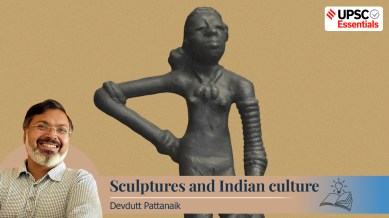© IE Online Media Services Pvt Ltd

(The Indian Express has launched a new series of articles for UPSC aspirants written by seasoned writers and erudite scholars on issues and concepts spanning History, Polity, International Relations, Art, Culture and Heritage, Environment, Geography, Science and Technology, and so on. Read and reflect with subject experts and boost your chance of cracking the much-coveted UPSC CSE. In the following article, Devdutt Pattanaik, a renowned writer who specialises in mythology and culture, delves into the evolution of sculptures from Mauryan pillars to bronze Natarajas of the Cholas.)
How is sculpture different from architecture? Architecture deals with dwelling places —homes, palaces, tombs, temples, mosques, monuments. It has a functional utility. Sculptures, on the other hand, are more aesthetic or ritualistic; they do not have a functional purpose.
From 1900 BC-300 BC we do not have sculptures. Vedic people did not make sculptures, at least not in durable materials. During the Mauryan Empire (320-185 BCE), royal sculptures were built on top of pillars. For example, the sandstone Lion Capital of Ashoka, with four life-like lions and the Dharma Chakra interspersed with four animals — a lion, an elephant, a bull, and a horse.
While Ashoka built many stupas, it was in the later centuries, under the Shungas and the Satavahanas, that the Stupas expanded with railings.
You have bas relief or shallow carvings on these railings of Sanchi and Bharhut stupas, around 100 BC, telling the story of Buddha’s life. Here, Buddha is depicted symbolically and there are scenes of urban life of people venerating the Buddha. Influence of Greek and Persian artists is evident here.
During the Kushan rule, around 100 AD, we have the period of Gandhara Art in the Swat Valley of present-day Pakistan and Mathura Art of Gangetic plains, and Amaravati art of the Krishna and Godavari delta on the eastern coast of India. These were major trading centres in the river basins of Indus, Ganga, Godavari and Krishna.
Early art shows Buddha symbolically but later, Buddha appears in form. There is much dispute if the first Buddha form was sculptured in Gandhara or Mathura. Kushan kings patronised imagery a lot – we find the image of Kanishka the king, which may have inspired artists to show the earliest image of Ashoka in the Buddhist site at Sannati in Karnataka’s Krishna basin.
Gandhara art uses schist stone or stucco plaster and is characterised by fine Roman grace, drapery and the nimbus (sun behind the head). Gandhara art was probably influenced by pagan artisans who migrated to India following the rise of Christianity in the Roman empire. There are giant bejewelled Yaksha and Yakshi images in Mathura, bulky like wrestlers, full of breath.
In this period we see the earliest Bodhisattvas indicating a shift in Buddhist thought, as well as early images of Hindu gods, especially Krishna-Vasudeva and Naga deities. In Mathura alone, we find the earliest Jain sculptures. The naked ascetics stand alone, without the yakshas and yakshis on either side. Amaravati school of art, also known as Andhra school of art, used a kind of marble-like limestone and had an extreme amount of ornamentation here. This art spread to Sri Lanka and thrived there till the 12th century CE.
From the Gupta period onwards we find the rise of various new Buddhist, Jain and Hindu deities carved on cave walls, especially in the Deccan region. Udayagiri, Ellora and Elephanta are cases in point where we find images of Buddha, Bodhisattva, Tara, Nagas, Shiva, Vishnu, Kubera, and many Jain Tirthankaras with Yakshas and Yakshis guarding them.
This became even more prominent in the period of Deccan Chalukyas (6th-12th Century CE) at Aihole, Badami, and Pattadakal. Shiva and Vishnu’s imagery abounds in basalt and granite material. After 800 CE when freestanding temples emerged in Odisha, Uttarakhand, the coasts of Andhra and Tamil Nadu and mountains of Maharashtra and Karnataka, sculptures were now found on these temples.
Around the 10th Century Chola period, the bronze Natarajas emerged, mobile sculptures that are made using the lost wax method. Recent research has shown that the copper for these came from Sri Lanka which is possibly why the Cholas constantly fought with Sri Lanka formerly called Thambapanni, the copper land.
Muslim rulers did not patronise sculptures as it was against Islamic belief. But stone and metal sculptures thrived in Hindu and Jain temples. When Europeans arrived, they brought the European style of sculptures which (were) idealised human bodies with musculature and with little ornamentation, very different from Indian statues, that displayed smooth contours, transparent fabrics and jewellery.
While these are the sculptures that have survived, we must also look at what might have not survived. Tribal groups, for example, would use clay to make idols, like the famous terracotta Bankura horses of Bengal. They were used as votives for rituals. Even today in Ganesh Chaturthi and Durga Puja, river-clay sculptures are prayed to and then dissolved. No trace of it is left.
Discuss and elaborate salient features of Gandhara art with examples.
What do the ancient sculptures from the Harappan Civilisation say about the artistic techniques and cultural practices of that era?
What is the dispute over the first sculptured form of Buddha? How did the patronage of Kushan kings, particularly Kanishka, influence early Buddhist imagery?
The flourishing of various art forms during the Kushan period reflects the rich and diverse cultural landscape of the time. What insights does this provide into the society and culture of that era?
(Devdutt Pattanaik is a renowned mythologist who writes on art, culture and heritage.)
Subscribe to our UPSC newsletter and stay updated with the news cues from the past week.
Stay updated with the latest UPSC articles by joining our Telegram channel – IndianExpress UPSC Hub, and follow us on Instagram and X.
Share your thoughts and ideas on UPSC Special articles with ashiya.parveen@indianexpress.com.